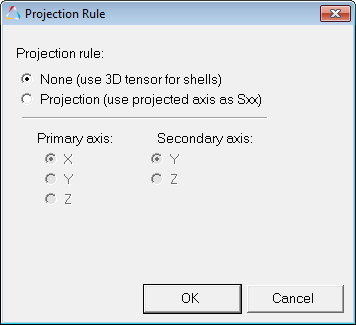Projection Rule |

|

|

|

|
|
Projection Rule |

|

|

|

|
For shell (or planar) elements, results in any 3D coordinate system can be projected onto the element plane. For averaged nodal results, the projection plane is called the nodal projection plane, which is the average of all element planes at that node. In a projected coordinate system in HyperView, the local x and y axes will always lie on the projected plane and local z-axis will be perpendicular to the plane. The projection rule defines how the local x axis is obtained. Since the local z axis is always known (from the normal direction of the plane), the y axis is obtained by the cross product of local z and local x.
In order to have a projected coordinate system, you must pick a 3D reference coordinate system from the resolved in pull down menu. This reference coordinate system can either be a global or a user-defined system. Then, the Primary axis (of the reference coordinate system) will be projected on the element plane to obtain the local x axis. If the Primary axis is perpendicular to the element plane, the Secondary axis will be projected to obtain the local x axis. You have the option to pick the Primary and Secondary axis from the Projection Rule dialog.
